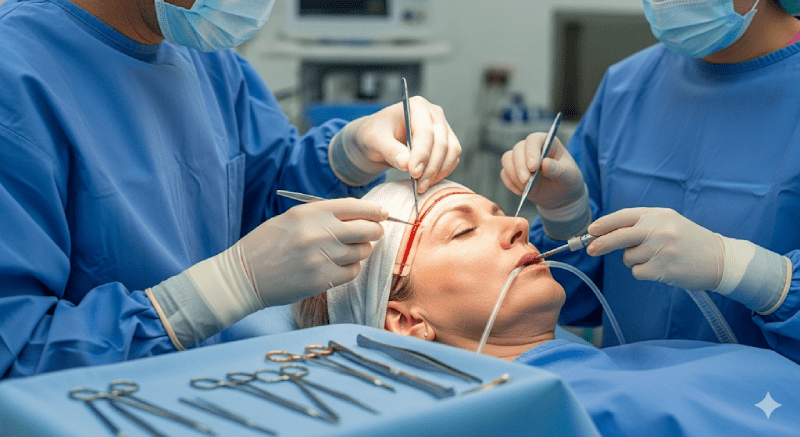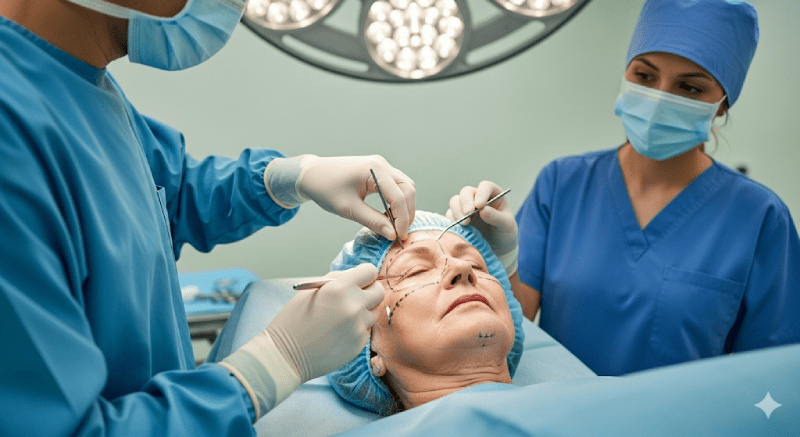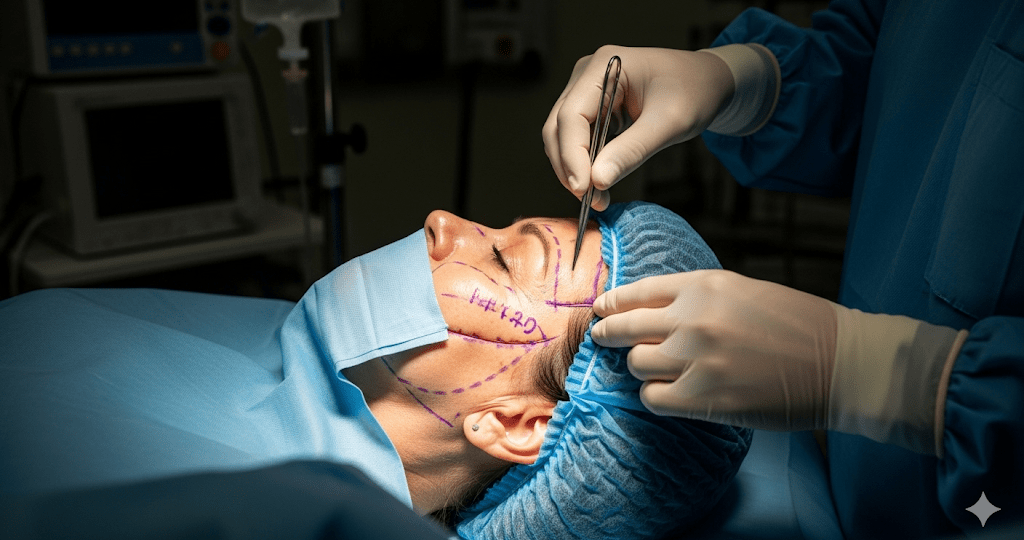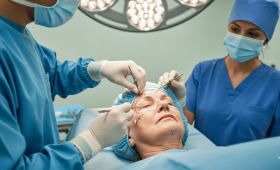What Is Facelift Surgery?
Facelift surgery is a surgical procedure aimed at eliminating the signs of aging on the face and neck. Also known as rhytidectomy in medicine, this operation is performed to correct sagging skin tissue, deep wrinkles, and relaxed muscles.
During the surgery, excess skin is removed, the underlying muscles and tissues are tightened, and the face is given a more youthful, vibrant, and refreshed appearance. The goal of this procedure is to achieve a younger look while preserving the person’s natural features. Different facelift techniques are determined according to the patient’s needs, and personalized results are obtained.
Who Is a Suitable Candidate for Facelift Surgery?
Suitable candidates for facelift surgery are typically individuals between the ages of 40 and 70 who have noticeable skin sagging and deep wrinkles on their face and neck. It is important that candidates are in good general health, have the physical capacity to handle the risks of the surgery, and have realistic expectations from the operation.
Smokers are required to quit smoking before the surgery. More successful and long-lasting results are achieved in people with good skin elasticity. The patient’s skin structure, bone tissue, and signs of aging are evaluated in detail by the surgeon.
What Are the Prices for Facelift Surgery in Turkey?
The prices for facelift surgery in Turkey are quite economical compared to Western countries. Prices vary depending on the surgeon’s experience, the hospital where the surgery will be performed, the technology used, and the scope of the operation (such as a full facelift, mini facelift, or neck lift combination). Generally, prices are offered in packages that include the surgery, anesthesia, hospital stay, medications, and post-operative care. These packages make all costs transparent for foreign patients, preventing unexpected additional costs. The affordability does not mean a compromise in quality; rather, it is due to Turkey’s general economic structure.
Why Is Turkey Preferred for Facelift Surgery?
Turkey has a worldwide reputation for facelift surgeries. The main reasons for this include the presence of expert and experienced surgeons, clinics and hospitals equipped with modern technology, high success rates, and affordable costs. Health tourism policies and government support have led to significant growth in this field. Additionally, the country’s cultural and historical richness makes the treatment process a holiday experience, which is attractive for patients.
How Long Does the Facelift Surgery Take?
The duration of facelift surgery varies depending on the technique applied and the scope of the operation. While a full facelift surgery usually takes between 3 and 6 hours, less extensive operations like a mini facelift can be completed in a shorter time. All necessary precautions are taken for the patient’s comfort and safety during the surgery. In long-lasting operations, surgeons and their teams take regular breaks to ensure the operation is completed in the best possible way.

What Is the Post-operative Recovery Process Like?
The recovery process after a facelift surgery usually begins with a one or two-night hospital stay. It is normal to experience swelling, bruising, and mild pain during the first few days after the surgery. These symptoms generally start to subside within a week. Patients can usually return to their normal social lives after 10-14 days. Full recovery and the final results becoming apparent may take a few months. Adhering strictly to the surgeon’s recommendations during this process speeds up recovery and increases success.
How Permanent Are the Results of Facelift Surgery?
The results of facelift surgery are long-lasting, but they are not permanent because the natural aging process continues. The surgery turns back time, giving your face a more youthful appearance. The results usually maintain their permanence for 10 to 15 years. To ensure the results last longer, it is recommended to pay attention to lifestyle habits such as regular skincare, a healthy diet, and sun protection.
What Are the Possible Risks and Complications of the Surgery?
As with any surgical procedure, facelift surgery has some risks and complications. Possible complications include bleeding, infection, reactions to anesthesia, nerve damage, and asymmetry. These risks are minimized when the surgery is performed by an experienced surgeon using the right techniques. It is important to have a detailed discussion with your doctor about the possible risks before the surgery.
Do Scars Remain After the Surgery?
In facelift surgery, incisions are made in the natural creases and hidden areas of the scalp in the temple region, and in front of and behind the ear. This way, the incision scars are not easily noticeable after the surgery. Over time, these scars fade and become almost invisible. The surgeon’s experience and the use of the right techniques are very important to ensure the success of the surgery and to minimize the visibility of the scars.
What Type of Anesthesia Is Used in Facelift Surgery?
Facelift surgery is usually performed under general anesthesia. This is a method where the patient is completely asleep during the surgery and does not feel any pain. General anesthesia allows the surgeon to perform the operation more comfortably and safely. Considering the duration and scope of the surgery, general anesthesia is the most suitable type for the patient’s comfort.
What Should Be Considered Before the Surgery?
It is vital to follow all the instructions given by your surgeon before the surgery. The use of blood-thinning medications and herbal supplements should be stopped at least two weeks beforehand. Smoking and alcohol consumption should be stopped at least one month in advance because these substances negatively affect the healing process. It is recommended not to wear makeup and to wear comfortable clothes on the day of the surgery. All these precautions help ensure the surgery is successful and safe.
Is There Pain After the Surgery?
The pain felt after facelift surgery is generally mild and can be easily controlled with pain relievers given to the patient after the surgery. The pain is felt most during the first few days. Applying a cold compress to reduce swelling and bruising also helps to alleviate the pain. The surgeon will prescribe the most suitable pain relievers to ensure the patient’s comfort.
When Can I Return to Work?
The recovery process after facelift surgery can be longer than a traditional facelift. Patients can generally return to their office jobs or jobs that do not require heavy physical activity within 10 to 14 days. The significant reduction in swelling and bruising on the face determines this period. Those who have more strenuous jobs are advised to rest for a few more weeks until the recovery process is complete.
What Is the Difference Between a Mini Facelift and a Full Facelift?
A mini facelift and a full facelift offer different methods and results. A mini facelift focuses only on the lower third of the face and is performed with smaller incisions. Therefore, the recovery process is faster and less invasive. A full facelift, on the other hand, covers the entire face (forehead, cheeks, chin, and neck) and is a more comprehensive operation. The traditional method is preferred for patients with more advanced signs of aging and who expect more pronounced results.
What Is Endoscopic Facelift?
Endoscopic facelift is a less invasive facelift technique performed with the help of a small camera (endoscope). This method is used to correct sagging in the forehead and brow area. The endoscope is inserted through small incisions in the scalp, allowing the surgeon to see and manipulate the tissues. An endoscopic facelift results in less swelling and bruising, and the recovery process is shorter than with traditional surgeries.
What Is Mid-Facelift?
Mid-facelift is an operation that targets the signs of aging in the middle part of the face, such as the cheeks, the wrinkles extending from the sides of the nose to the lips, and under-eye bags. This surgery provides a more youthful and vibrant appearance by restoring volume to the under-eye area and cheeks. A mid-facelift is often combined with eyelid surgery to achieve more effective results.
How Does Facelift Surgery Affect Smoking and Alcohol Consumption?
Smoking and alcohol negatively affect the healing process before and after the surgery. Smoking reduces blood flow and prevents tissues from getting oxygen, which slows down wound healing. Alcohol thins the blood, which increases the risk of post-operative bleeding and bruising. Therefore, it is vital to stop the use of these substances before the surgery.
What Is Included in the Price of Facelift Surgery?
Facelift prices in Turkey are generally offered as all-inclusive packages. These packages usually include the surgical operation, anesthesia fee, a one or two-night hospital stay, medications, post-operative check-ups, airport transfers, and in some cases, hotel accommodation. This way, patients can know all the costs of their treatment process in advance and do not face any additional costs.
What Is the Consultation Process for Foreign Patients Like?
Aesthetic surgery clinics in Turkey generally offer an online consultation process for foreign patients. Patients send photos of the area they are considering surgery on and their medical history to the surgeon via email or video conference. The surgeon evaluates this information to determine if the patient is suitable for the surgery and creates a preliminary treatment plan. When the patient arrives in Turkey, a detailed face-to-face examination is performed, and the final details of the surgery are clarified.
How Experienced Are the Surgeons in Turkey?
Since Turkey is one of the leading countries in the world in health tourism, its aesthetic surgeons are very experienced. Surgeons who perform thousands of operations a year have gained extensive experience with different facial structures and aesthetic expectations. This experience allows for higher success rates and more natural results to be obtained.
Which Age Group Is Most Suited for Facelift Surgery?
Facelift surgery is generally most suitable for individuals in their 40s and 50s. At this age, the signs of aging are just beginning to appear, and the skin still has good elasticity. Therefore, the results of the surgery are more natural and successful. It can also be performed on younger or older patients, but the surgeon needs to evaluate the person’s skin structure and general health condition.
What Is the Success Rate of Facelift Surgery?
The success rate of facelift surgery is very high, depending on the surgeon’s experience and the patient’s adherence to post-operative instructions. Thanks to the experienced surgeons and modern hospitals in Turkey, the success rates are quite high. The goal of the surgery is to give the person a more vibrant and youthful appearance, and this goal is usually achieved successfully.
Does the Facial Expression Change After the Surgery?
A facelift performed with the right techniques does not change facial expression. On the contrary, it gives a more vibrant, fresh, and youthful appearance while preserving the person’s natural facial contours and expressions. The surgeon’s goal is to obtain natural results by avoiding an exaggerated and artificial look.

Is a Second Facelift Surgery Required?
The results of facelift surgery are not permanent because the aging process continues. A second surgery may be required, usually after 10 to 15 years, when the sagging on the face becomes noticeable again. A second surgery helps to maintain the youthful appearance of the face and can refresh the results of the first surgery.
Who Cannot Have Facelift Surgery?
Facelift surgery cannot be performed on individuals with uncontrolled serious health problems (such as diabetes, heart disease), bleeding disorders, or those who have unrealistic expectations from the surgery. In addition, this operation is not suitable for individuals who are found to be unsuitable for general anesthesia during tests performed before the surgery. The decision for surgery is made by taking all these factors into consideration.
What Should Nutrition Be Like After the Surgery?
It is recommended that patients eat soft and liquid foods for the first few days after the surgery. Pureed foods and soups that do not require chewing should be preferred. It is important to avoid hot and spicy foods. As the healing process progresses, one can gradually return to a normal diet. This way, the tension and sensitivity in the surgical area can be reduced.
Which Aesthetic Operations Can Be Combined with Facelift Surgery?
Facelift surgery can be combined with other aesthetic operations to achieve a more comprehensive result. The most commonly combined operations include eyelid aesthetics (blepharoplasty), neck lift, and fat injection. These combinations provide a more holistic and harmonious rejuvenation on the face as a whole. The surgeon will recommend the most suitable combination according to the patient’s needs and aesthetic goals.
What Is the Difference from Neck Lift Surgery?
Facelift and neck lift surgeries are often performed together but have different purposes. A facelift focuses on correcting sagging and wrinkles in the mid and lower parts of the face, while a neck lift surgery tightens the relaxed muscles and excess skin on the neck. Since a facelift can also correct sagging in the jawline, combining it with a neck lift provides a sharper and younger profile.
When Does Swelling Go Down After the Surgery?
Facial swelling after the surgery reaches its peak within the first 24-48 hours. After that, the swelling slowly begins to go down. A significant reduction takes a week. It can take 3 to 6 months for all the swelling on the face to completely go down and for the face to take its final shape. It is important to be patient during this process and follow the doctor’s recommendations.
Are There Language Services for Foreign Patients?
Yes, many aesthetic surgery clinics in Turkey have international patient departments specifically designed for foreign patients. These departments employ translators and patient coordinators who provide services in languages such as English, German, Arabic, and others to solve patients’ communication problems. This service ensures that patients feel safe and comfortable throughout their treatment process.
How Long Do I Need to Stay in Turkey for Facelift Surgery?
For foreign patients, the facelift surgery process usually takes 7 to 10 days. On the first day, patients arrive and settle in the clinic. The surgery is performed on the second day, and a one or two-night hospital stay may be required. Staying in Turkey for a few more days is beneficial for the first stages of recovery and the first check-ups.
Are Pre-operative Blood Tests Necessary?
Yes, pre-operative blood tests are mandatory. These tests are performed to evaluate the patient’s general health condition, blood values, and bleeding and clotting times. The test results are of critical importance to determine if the patient is suitable for the surgery. Surgeons make the surgery plan based on these test results.
Does Facelift Surgery Differ by Gender?
Facelift surgery can be applied to both women and men, but the techniques may differ by gender. In men, it is more important to preserve the facial and jaw lines, so the surgeon may use different incision lines. The beard growth areas in men also affect the operation planning. For both genders, the goal is to achieve a natural and youthful appearance.
When Can I Return to Sports Activities After the Surgery?
Heavy sports activities should be avoided after the surgery. Light walks can be done in the first week. It is recommended to avoid heavy exercises, weightlifting, or movements that strain the face for two to four weeks. The decision to fully return to sports should be made with the doctor’s supervision and approval.
What Are the Differences Between Facelift Surgery and Non-Surgical Methods?
Facelift surgery offers more permanent and noticeable results compared to non-surgical methods (fillers, botox, thread lifting, laser). Non-surgical methods are ideal for mild signs of aging and need to be repeated regularly. Facelift surgery is the most effective solution for more advanced sagging and wrinkles.



